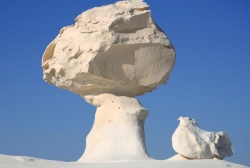ABOUT US
FIND YOUR EGYPT TRIP
Find best priced trips in Egypt..
Egypt Travel Blog
THE OASES AND THE FAYYUM
25/11/2011
Ready to discover Oases? The very word “Oasis” conjures a string of images-swirling sands, blue-veiled Tuaregs, mirages, the thirsty caravan stumbling into a pool of sweet water set amidst swaying palms. As always, little of this vision has any foundation in modern reality: the caravans have all but vanished, banditry has been suppressed, and the Bedouin have traded their camels in for Toyotas. Not even the vestiges of modern man, however, in the form of asphalt, high tension wires and water pumps, are capable of concealing the truths of a harsh climate, where shifting sands can block roads for days and where the foolhardy can still meet death by thirst, exposure, or the sting of a scorpion. Nor have 20thcentury wonders obscured the essential miracle of water, gushing hot or cold from barren rock to irrigate acres of garden in the midst of a wasteland. From the Nile, the Sahara strectches 3,000 miles (5,000km) westward to the Atlantic: The world’s greatest expanse of desert is broken only by some several score dots of green, where human habitation has survived the spread of sands. Contrary to popular imagination, which sees verdure sprouting incongruously from dunes, oases generally lie in rocky lands where wind and time have scratched out vast depressions whose depths allow natural underground aquifers to reach the surface. In Egypt’s Western Desert a single aquifer flows north from Sudan, running in an arc of five oases roughly parallel to the Nile. Prehistoric remains show that man has been exploiting nature’s gift since at least 5000 BC. Under the pharaohs the four Nileward oases – Kharga, Dakhla, Farafrah and Bahariyya - formed a line of defense against marauding Libyan tribes. The camel, the only beast capable of five days’ march without water, was introcuded by invading Persians in the 6th century BC and provided the oases with their first great leap forward, matched in importance only recently with the introduction of electricity and the automobile. The camel helped to revive the desert economy. The new beast was no help to the Persian emperor Cambyses, however, when he dispatched his army from Kharga across the desert to Siwah in 525 BC. According to Herodotus, all 50,000 men were buried in a sandstorm. The Ptolemies, who ran the country like a vast estate, set about improving desert agriculture. Archeological remains show that cultivation grew to its furthest extent undertheirrule; new wells were dug with Alexandrian technology and the complex systems of water distribution that still persist were brought into use. Roman conquest led to a reversal of fortunes. The internal unrest of the late roman period saw banditry increase at the expense of sedentary agriculture, while persecutions forced Christians into desert refuge, as the many Christian remains in the oases testify. Wells that had been regularly repaired and cleaned were allowed to dry up, as a general decline in population , lasting up to the present century, set in. Although the date of the last Christian conversions to Islam is not known-the present inhabitants of the oases being solidly Muslim-it is likely that the new religion, so well suited to desert ways, made easy headway in the oases. The charm, generosity, and peaceability of the inhabitants owe much to Islam. In a landscape seemingly touched by God-abundance amidst waste-a touching humility of outlook is so appropriate as to seem unsurprising. Al-Kharga (The Outer) Oasis is the most frequented of Egypt’s oases, by virtue of its proximity to the Nile and because it is the seat of the New Valley Governorate. Although it is linked by twice-weekly flights from Cairo and Luxor, most travellers prefer the overland route. Three miles (5 km) north of Asyut, a fine paved road leads past a new industrial complex up into the desert. One hundred and twenty miles (200 km) of barren gravel later, the road descends suddenly down a magnificent cliff into the Kharga Depression, which extends southwards, narrowing at its extremity, for 60 miles (100 km). As one crosses the flat bottom of the depression, few straggly trees appear on the roadside, inauspiciously announcing the beginning of cultivation. Then Nasserite housing blocks begin to sprout, marking the entrance to Kharga town. Visitors to the oases should not be too disappointed by the town. It is merely an administrative centre and a showpiece of the New Valley project, initiated by Abdul Nasser in the later 1950s. The project, the aim of which was to utilise the vast potential of the oases’ waters for land reclamation and new settlement, has met with considerable succes. Much of Kharga’s population consists of resettled Upper Egyptians; and the new hotels, duck farms, and packaging industries point to a fair degree of prosperity. With the exception of its old market there is not much to see in the modern town, however. Just northeast of the town, not far from the main road, lies a cluster of monuments. Chief among them is the Temple of Hibis, important as one of the few remnants of Persian rule. Built of local sandstone, it was begun under Cambyses’ succesor Darius I, but not completed until the reign of Nectanebo II in the 4th century BC. The temple lies in a palm grove beyond the remains of a ceremonial pool and an avenue of sphinxes. The carving style within shows local influence, while the content of the reliefs-deities, the burial of Osiris, a winged Seth struggling with a serpent - follows a standard pattern. At the edge of culvivation to the north of the temple lies the Christian necropolis of Al-Bagawat, a huge area of mudbrick domes and vaults, some of which preserve decoration. A kilometre’s hike across the sand leads to the ruins of a fortified monastery. South of Kharga town a paved road extends through a string of smaller oases, past some minor antiqities, to Baris, the village designed by renowned architect Hassan Fathi.


